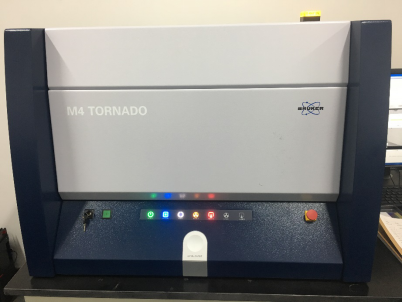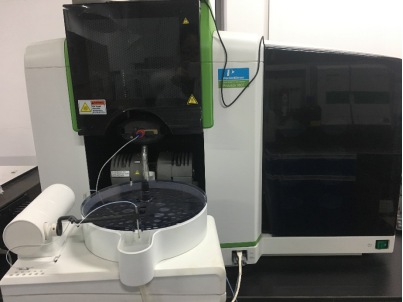Introduction
Marine chemical analysis laboratory located in Lingang campus lab building 1st floor and 2nd floor. It is mainly used for the earth chemical experiment and analysis,the laboratory mainly includes sample preparation room and instrument analysis room.
Main instruments: key laboratory analysis instruments including the following several: high-performance micro X-ray fluorescence spectrometer (XRF), carbon and nitrogen analysis combination instrument (TOC), atomic absorption spectrometer (AAS), liquid scintillation counting instrument, etc.
1. XRF(Bruker,型号M4 Tornado):
The M4 Tornado micro-XRF is an energy dispersive X-ray spectrometer designed specifically for the analysis of large sample areas. Not only can do single point element analysis of the sample, and has the function of line scanning, the surface scan. The M4 Tornado uses a silicon-drift detector(30 mm2) to identify elements with an atomic number ≥ 11 (Na and heavier), energy resolution < 140 eV for Mn-K,making it well-suited for geological materials.The M4 Tornado can analyze and map flat or rough surfaces up to 200 x 160 mm, eliminating the need for samples preparation (such as thin sectioning). Micro-XRF spectroscopy is rapid, non-destructive, and adaptable to many different types of materials, it could prove to be a useful tool for characterizing and classifying geology.

2. Carbon and nitrogen analysis combination instrument ( Jena, Model Multi N/C3100):
The analyzer multi N/C 3100 is a device to determine the total carbon content and/or total nitro-gen content in aqueous samples. Detection is by way of thermocatalytic digestion in the pres-ence of a special catalyst in accordance with the national and international standards. Instruments have NDIR detector, as well as the total nitrogen of CLD, ChD detector without dilution, able to accurately measure. Thanks to its patented high focus non-dispersive infrared. It has unique VITA ® patented velocity control signal processing technology, improving equipment performance, guarantee the stability of high precise measurements. Just a standard solution to complete correction and long-term stability. TC, TOC, NPOC, TIC, POC and TNb parameters can be fast and accurate measurement. Flexible configuration, high automation degree, and can meet the needs of different users.

3. Atomic Absorption Spectrometer(PerkinElmer,Model PinAAcle 900T):
The equipment is used for determination of iron, manganese, copper, lead, zinc, chromium and other trace elements in water or sediment, can be widely used in ocean chemistry, analytical chemistry, and biogeochemistry research and education. The instrument can realize the flame and graphite furnace integration test, eight lights can be configured at the same time, save the change and test time. It adopted the forefront of fiber optical path design, higher flux, avoid the lens and other optical components become dirty, reducing maintenance, to ensure the instrument has high sensitivity, it has strong anti-interference ability.

4. Liquid scintillation counter(PerkinElmer,Model Tri-Carb 2910TR):
Tri-Carb liquid scintillation counter is currently the most, the highest sensitivity testing instrument, it is controlled by computer desktop device, used to detect low alpha and beta radioactive trace. It can be directly used in basic research and CPM/direct DPM measurement applications, can be extended when necessary to meet the demand of more applications. Interactive interface provides easy-to-use QuantaSmart logic dialog box, easy for data management, multitasking, user security and network connection, minimize counting error at the same time, the results of the automatic generation of reliable and easy to read the report.
Contact Person:Huaiyang Zhou & Yushuang Zhang

